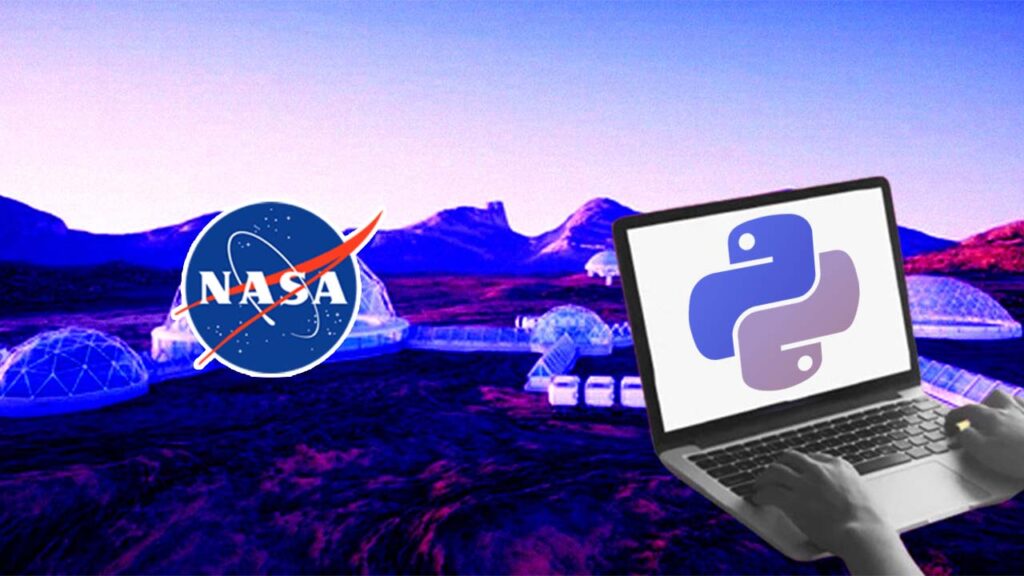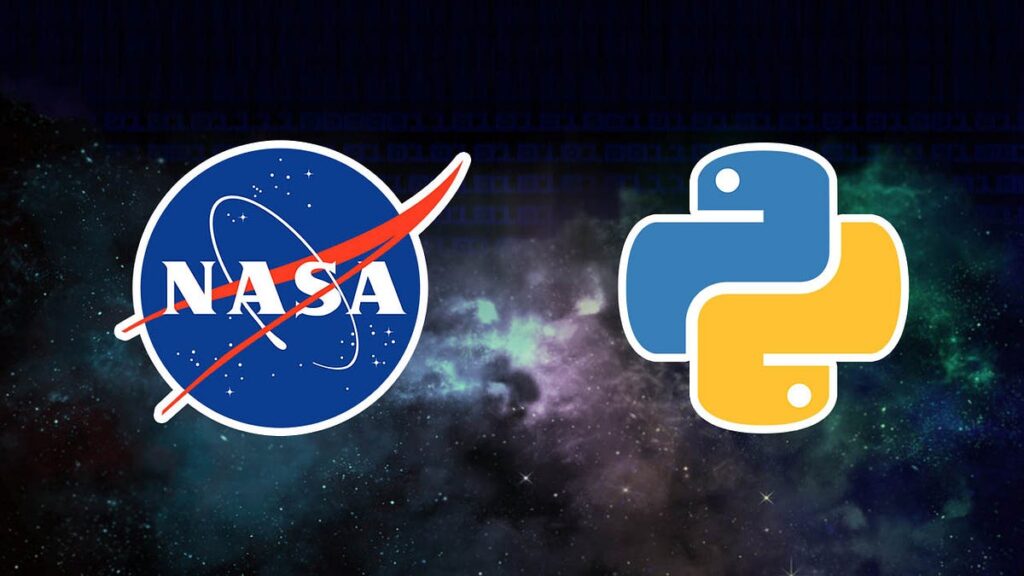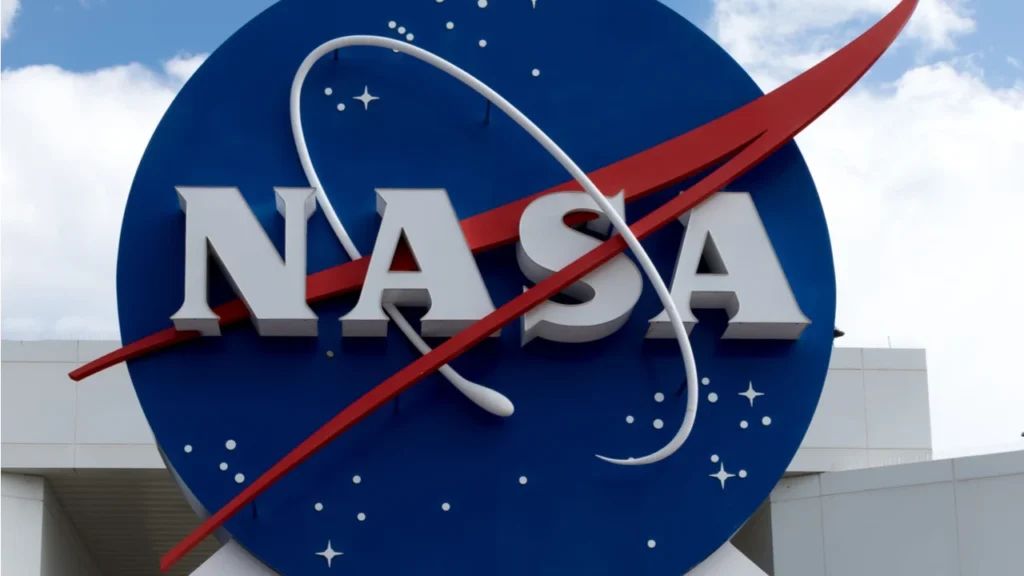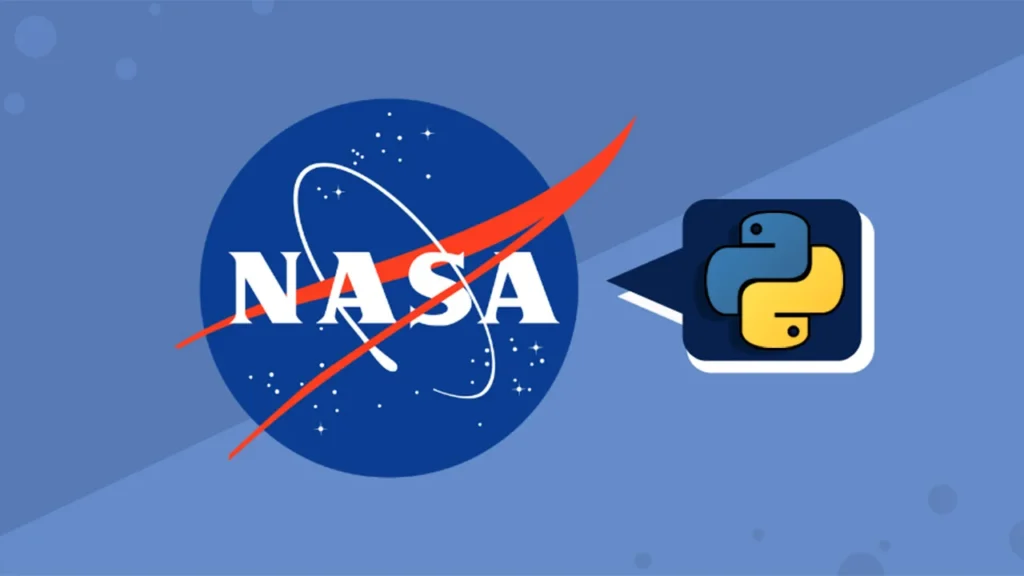NASA employs Python due to its versatility and simplicity. Python’s straightforward syntax and readability make it accessible to scientists and engineers across various disciplines.
It offers a rich ecosystem of libraries and frameworks tailored for tasks like data analysis, scientific computing, and artificial intelligence, essential for missions. Python’s open-source nature eliminates licensing fees, enabling cost-effective software development.
Its cross-platform compatibility facilitates collaboration and integration within its complex systems. Moreover, Python’s rapid prototyping capabilities allow NASA to iterate quickly on ideas and algorithms before full-scale implementation.
With Python, they can efficiently process and visualize data from space missions, enhance spacecraft operations through machine learning, and drive innovation in space exploration.
What Is Python?

Python, created by Guido van Rossum and introduced in 1991, is a high-level, multipurpose programming language known for its simplicity and readability. It has garnered widespread adoption across various domains such as web development, data analysis, scientific computing, artificial intelligence, machine learning, and automation.
Moreover, it is clean syntax makes it appealing to both beginners and experienced developers. Its comprehensive standard library and vast ecosystem of third-party packages further enhance its versatility and usefulness.
Being open-source and compatible with multiple platforms, Python stands out as a preferred choice for developers and organizations worldwide.
What Is NASA?
NASA, which stands for the National Aeronautics and Space Administration, is like the big boss of space stuff for the United States. They’ve been around since 1958 and have done some pretty cool things, like landing people on the moon with the Apollo missions and sending rovers to explore Mars.
But it’s not just about going to space; they also study Earth’s climate and look at what’s out there in the far reaches of space. They work with other countries too, so it’s like a big team effort to learn more about space and our place in it. It is all about exploring and discovering new things beyond our planet.
Which Programming Language Does NASA Use?

NASA utilizes a variety of programming languages to power its missions and operations, reflecting the diverse needs of its projects. Among these languages, Fortran holds a prominent place, dating back to the early days of computing and remaining vital for legacy systems. Notably, Fortran was instrumental in missions like the Apollo moon landing and the Space Shuttle program.
While Fortran continues to play a role in maintaining reliability for longstanding systems, it has embraced more modern languages such as C++, Java, and Python. C++ finds application in spacecraft and satellite operations, while Java is utilized for ground-based data systems. Python’s popularity is on the rise within NASA, particularly in scientific computing and data analysis tasks.
Moreover, Its choice of programming language is influenced by several factors. The reliability and predictability of Fortran make it indispensable for mission-critical systems, ensuring compatibility with aging hardware.
Additionally, the availability of open-source libraries and tools plays a significant role. Its extensive ecosystem of scientific computing libraries and the prevalence of open-source solutions like Linux and Apache contribute to its growing adoption within it.
Ultimately, NASA selects programming languages based on the specific requirements of each project. While Fortran remains prevalent in legacy systems, newer languages like C++, Java, and Python are increasingly favored for modern initiatives, showcasing its commitment to innovation and adaptability in the realm of software development.
Why does NASA Use Python?
NASA utilizes Python as a powerful tool in their arsenal, aiding in various tasks and projects within the organization. Python’s appeal lies in its accessibility, versatility, and robust support system, making it particularly well-suited for space exploration and scientific pursuits.
The decision to employ Python stems from several factors. Its simplicity and readability cater to scientists, engineers, and researchers. They may not have extensive programming backgrounds but require software for tasks like data analysis and simulations.
Moreover, its prevalence in the scientific community, especially for data analysis and visualization, aligns seamlessly with NASA’s data-intensive missions.
The language’s extensive library ecosystem, including NumPy, SciPy, and Matplotlib, enhances its capability to handle complex scientific computations and data manipulation. Additionally, Python’s open-source nature and thriving community support reflect its commitment to knowledge sharing and collaboration.
How does NASA benefit from using Python?

NASA leverages Python for a multitude of reasons:
Ease of Learning and Use
Python’s simplicity and readability make it accessible to scientists, engineers, and researchers, enabling them to develop software for diverse tasks like data analysis and simulations efficiently.
Large Ecosystem
Its extensive ecosystem of libraries and frameworks tailored for scientific computing and data analysis provides NASA with a versatile toolkit to address complex challenges.
NumPy offers robust numerical computing, SciPy provides advanced scientific algorithms, Matplotlib aids in intricate data visualization, and pandas streamlines data manipulation.
The diverse toolkit empowers NASA to efficiently handle tasks, from satellite image processing to modeling astrophysical phenomena, aiding scientists and engineers.
Community Support
With a robust community of users and developers, Python offers extensive online resources and support forums, empowering NASA’s workforce to tackle coding challenges effectively.
Cross-Platform Compatibility
Its cross-platform compatibility is particularly advantageous for NASA’s collaborative projects and diverse computing environments. Whether working on Windows, macOS, or various Linux distributions, NASA teams can seamlessly share code and collaborate across different platforms.
This compatibility extends beyond traditional computing systems to include embedded devices and high-performance computing clusters, ensuring consistency and interoperability across the agency’s computing infrastructure.
Integration Capabilities
Python seamlessly integrates with other languages like C/C++ and Java, enabling NASA to leverage existing software infrastructure while developing new tools and applications.
Data Analysis and Visualization
Its specialized libraries for data analysis and visualization play a crucial role in NASA’s mission-critical activities.
For instance, when analyzing data collected from space missions or satellite observations, tools like NumPy and pandas enable efficient data processing. Matplotlib and other visualization libraries allow scientists to create insightful visualizations for interpreting and communicating their findings.
These capabilities are essential for understanding complex scientific phenomena, guiding mission planning, and communicating results to the public and stakeholders.
Rapid Prototyping
Python’s agility and quick development cycle facilitate rapid prototyping, enabling NASA to swiftly test algorithms and concepts before full-scale implementation.
Open Source
Python’s open-source nature aligns with its commitment to transparency, collaboration, and cost-effectiveness. By leveraging open-source software, NASA avoids licensing fees and vendor lock-in, maximizing flexibility and control over its software ecosystem.
Furthermore, as an active participant in the open-source community, it contributes its own code and tools. This fosters innovation and knowledge sharing within the broader scientific and engineering community.
This collaborative approach accelerates technological advancements and promotes the agency’s mission of advancing space exploration for the benefit of humanity.
Scalability
Python’s performance enhancements, coupled with optimization tools like Cython or Numba, ensure scalability for computationally intensive tasks, meeting its evolving computational requirements.
Machine Learning and Artificial Intelligence
It has a rich ecosystem of machine learning and AI libraries. For example, TensorFlow and PyTorch empower it in tasks like image recognition, natural language processing, and autonomous robotics. These are crucial for advancing space exploration endeavors.
FAQ’s
What coding language does NASA use?
NASA developed its own programming language called HAL, with variations such as S for ships and G for control centers in the 1970s. However, nowadays, Python is extensively used by NASA for various purposes, including spacecraft simulations and mission planning.
How is Python used in the space industry?
Engineers in the space industry utilize Python for tasks such as creating simulations of spacecraft trajectories, orbital mechanics, and atmospheric interactions. Python’s flexibility and ease of integration with hardware interfaces make it well-suited for spacecraft control systems and mission planning.
Does SpaceX use Python?
Yes, SpaceX relies heavily on Python for a wide range of tasks, including designing and testing rockets, as well as monitoring spacecraft in orbit. Python’s versatility and powerful features make it an integral part of SpaceX’s operations.
Final Words
NASA uses Python because it’s easy to learn and has lots of tools for different jobs. It helps NASA scientists and engineers do things like analyze data, build models, and even teach computers to learn.
Plus, it doesn’t cost anything to use, which saves money. With it, they can explore space faster and better, making new discoveries and helping us understand more about the universe.
